back to Pet Cases
5/6/2014
Name: Cupcake
Owner: Matthew Deutsch
Medical History
Canine
Female
Shih tzu
Born: ??, 14 years old.
15 lbs.
Right-sided heart failure
Ascites requiring abdominocentesis every few weeks.
Vetmedin (pimobendan): increases cardiac output, 1.25 mg twice daily
Enalapril: ACE-I, 2.5 mg twice daily
Lasix (furosemide): diuretic, 15 mg three times a day
Multivitamin with 15 IU vit E, 1/2 tab daily
4 days prior to procedure, began taking 80 mg. aspirin per day.
Procedure
This was a planned event. A local veterinarian came to our facility to perform the euthanasia. Temperatures listed below are from the nasopharyngeal thermocouple.
| Time | Time PP | deg C | |
| 9:55 am | Veterinarian started an IV in the right foreleg and administered a sedative in her mobile van. | ||
| 10:01 | Veterinarian administered 0.5 mL heparin sodium 10,000 USP Units/mL through IV line at our request. | ||
| 10:03 | Moved from van into our facility | ||
| 10:08 | Veterinarian administered lethal of pentobarbatol with dilantin | ||
| 10:08 | Placed on right side on a bed of ice while veterinarian continued to listen for a heartbeat | ||
| 10:12 | 0:00 | Veterinarian pronounced death. | |
| 10:12 | Began chest compressions | ||
| 10:14 | 0:02 | 33 | Placed thermocouple through left nostril, 3 cm to nasopharynx. Secured with tape to keep water out of nose. |
| 10:18 | 0:06 | 7 mL Sodium Citrate 200 mg/mL into IV line, followed with 6 mL saline. Chest compressions continued. | |
| 11:15 | 1:03 | 10 | Surgery started. Midline incision made from sternal notch down to xyphoid process. Incisions extended laterally. Skin reflected to both sides. Shears used to cut through all ribs 5 cm to each side of midline. Sternum and attached sections of rib removed completely and set aside. Retractors applied. Heart was noted to be enlarged. Descending aorta was clamped above diaphragm. Right atrium was located. While isolating the major arteries, the brachiocephalic artery began to leak, and it was decided that the cannula would be placed at that location. |
| 11:46 | 1:34 | 6.7 | Cannula secured with 4-0 silk, and perfusion began. 10 seconds later, an incision was made in the right atrium. Effluent from the right atrium was slow to moderate and was suctioned continually. |
Perfusion Circuit
The open circuit consisted of the following components:
Bags of perfusate, 2 L each
Y-tubing for attaching 2 bags at the same time. Only one bag is flowing. This is how bags are switched.
Roller pump with 3/16 shoe
Analog manometer connected via isolator
40 micron filter from pediatric set
Heat exchanger connected to container with ice water, isopropyl alcohol, and some dry ice toward the end
Temperature probe through a luer lock t-connector extending 1 cm upstream into the liquid. This is the arterial temp shown in the table below.
Cannula, metal 90 degree
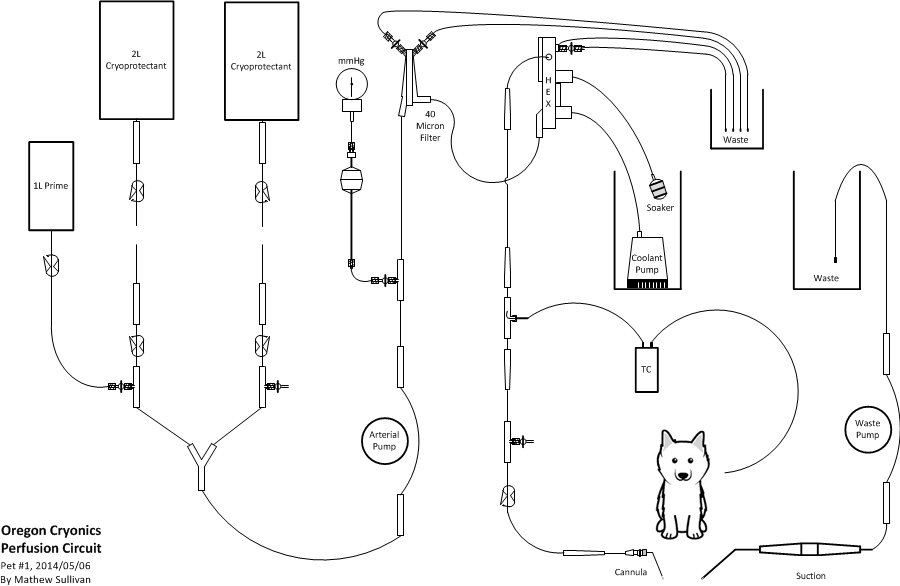
Perfusion
It was a stepped M22 perfusion with 7 steps. The solutions had been mixed two years previously and were left over from another case. The times and temperatures listed below are for when each bag was started.
| Time | Time PP |
deg C (art) | deg C (pat) | Bag Label | Brix | Qty | Notes |
| 11:46 | 1:34 | 12.7 | 6.7 | 3 | 9.7 | 1.9 L | |
| 12:14 | 2:02 | 1.8 | 5.8 | 4 | 13.0 | 1.4 L | Cannula adjusted and inserted further. Effluent flow rate was much improved and the effluent quickly turned from red to clear. No blood coagulation was seen at any time during the entire procedure. Bilateral edema noted in neck. |
| 12:35 | 2:23 | 0.1 | 5.0 | 5 | 14.2 | 1.5 L | |
| 12:53 | 2:41 | 0.2 | 4.6 | 6 | 20.4 | 1.4 L | |
| 1:09 | 2:57 | -0.3 | 4.3 | 7 | 27.7 | 1.3 L | |
| 1:24 | 3:12 | -0.8 | 4.0 | 8 | 38.9 | 1.2 L | At 1:27, eyelids of both eyes were observed to be white, and both eyeballs were normal firmness. |
| 1:42 | 3:30 | -1.8 | 4.1 | 9 | 52.3 | 0.7 L | At 1:48 pm, both eyeballs were softer and somewhat dehydrated. |
| 2:01 | 3:49 | -0.5 | 4.1 | end perfusion | 50.1 | N/A | Stopped at request of the pet owner. |
Pressure was monitored throughout the procedure, but it was line pressure rather than patient arterial pressure. Afterward, the circuit pressure was tested with both water and ethylene glycol at various flow rates. Subtracting these baseline values from the observed pressure readings gave estimates for arterial pressure fluctuating generally between 100 and 150 mm Hg.
Temperature:
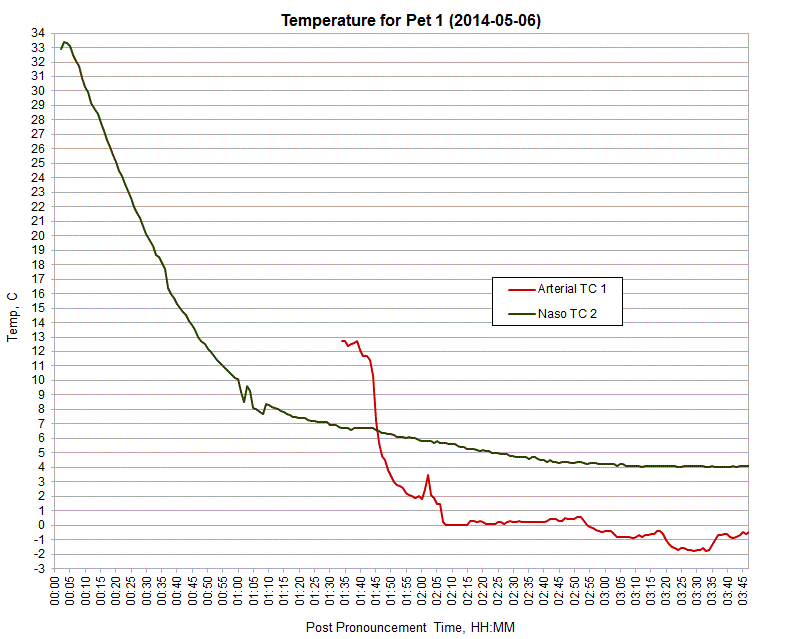
Arterial rate of flow was derived from the speed setting on the roller pump:
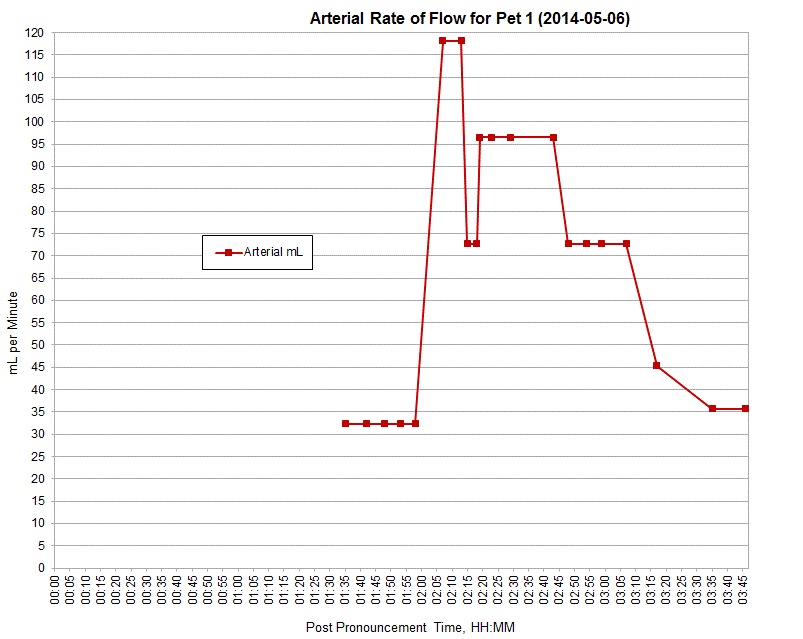
Refractive Index:
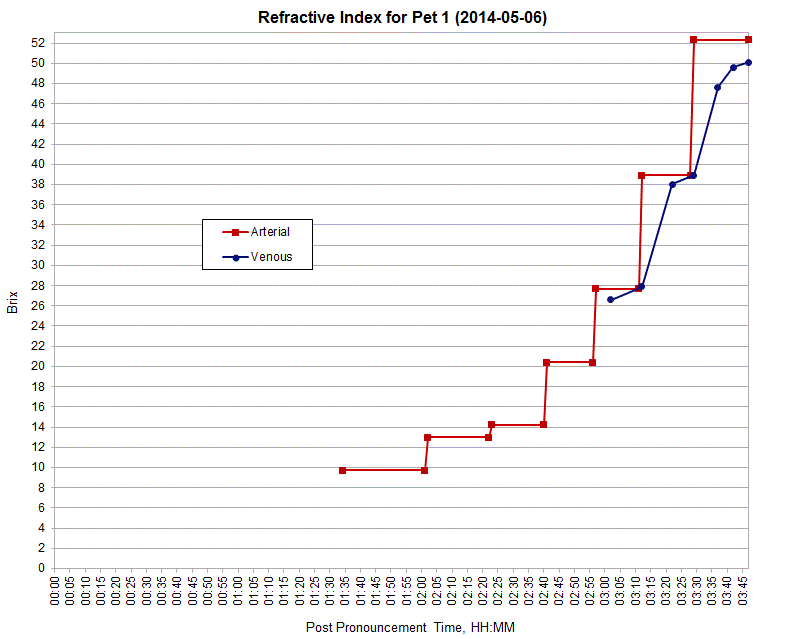
Surgical Isolation
Soft tissue was removed from the entire superior and posterior areas of the skull with a scalpel. Partial thickness cuts were made with a Stryker oscillating bone saw around the perimeter of the exposed area. Narrow ronguers were used to snip out a full-thickness channel of bone around most of the perimeter. The brain was noted to be retracted from the interior surface by 5 mm. The section of bone was removed and set aside. The optic chiasma and all cranial nerves were transected. The spinal cord was transected superior to the foramen magnum. The brain was only slighly dehydrated and was still fairly soft. Surgical isolation took 12 minutes.
The brain was placed on Dacron wool in an open container, and lowered into liquid nitrogen vapor for cool down. After seven days, the container was lowered until it was floating on the LN
Results
This picture was taken just prior to being submerged in liquid nitrogen. The temperature, as read from the thermocouple at the upper right of the image, is -155 deg C. The areas of frost seen at the bottom and left are only on the surface rather than within the tissue. The brain appears to be uniformly vitrified with no visible freezing damage.
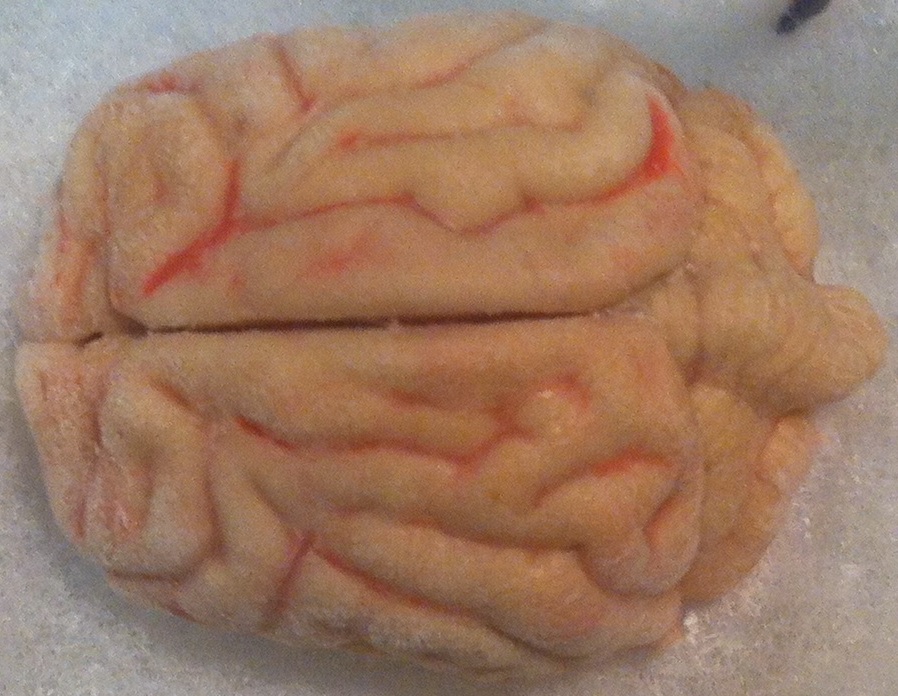
Quality
Ischemic Time Preperfusion
time0 is one minute after administration of pentobarbatol, 3 minutes prior to pronouncement. The first 5 minutes and last 10 minutes of temperature data were estimated for the calculation. Since CPS was started within 5 minutes, we assume there was adequate cerebral perfusion for the first 10 minutes of CPS, and that 10 minute span is excluded from the contribution towards the score. This assumption puts loss of cerebral perfusion at 30 deg C.
Score: 16 minutes
Ischemic Time Total
Score: 25 minutes
Percent Shrinkage
D=80mm, shrinkage=5mm. r1=40, r2=37.5
Score: 17.6% shrinkage
